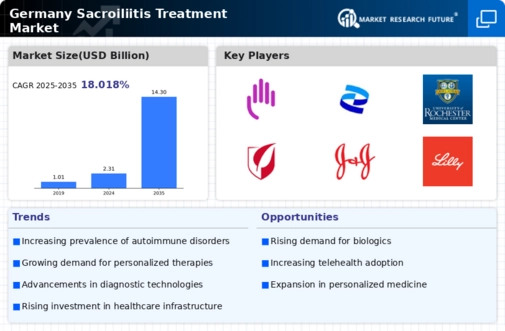The Germany Sacroiliitis Treatment Market presents a dynamic competitive landscape characterized by various companies striving to establish their presence and enhance treatment options for patients dealing with this condition.
The market is segmented into several therapeutic approaches, including biologics, traditional disease-modifying antirheumatic drugs, and targeted therapies, reflecting the need for specialized treatments tailored to individual patient requirements.
Innovation and research play significant roles as key players look to develop advanced solutions that not only alleviate pain but also address underlying causes of sacroiliitis. The interplay between established pharmaceutical firms and emerging biotechnological companies fuels competition, driving advancements in therapeutic offerings and improving health outcomes for patients.
Bristol-Myers Squibb has carved a niche in the Germany Sacroiliitis Treatment Market through its robust portfolio that reflects a commitment to addressing autoimmune diseases, including ankylosing spondylitis, which can lead to sacroiliitis.
The company’s key strength lies in its extensive research and development capabilities, which facilitate the introduction of novel therapeutics that meet the unique needs of German patients. The firm's established reputation in immunology allows it to leverage its experience and relationships with healthcare professionals and stakeholders, enhancing access to its innovative treatment options.
With a strong emphasis on clinical studies and patient education, Bristol-Myers Squibb aims to build a comprehensive approach for improving patient quality of life in the German market.
Amgen also holds a significant position in the Germany Sacroiliitis Treatment Market, focusing on the biological treatment segment. Known for its innovative therapies, Amgen’s product line includes powerful biologics designed to modulate immune responses effectively. The company's strategic partnerships and collaborations underscore its commitment to expanding its reach within Germany.
Through acquisitions and mergers, Amgen has enhanced its capabilities, allowing for a more extensive offering that integrates cutting-edge technology and research. This position is strengthened by a strong emphasis on regulatory compliance and active participation in local health discussions, solidifying Amgen's role in shaping treatment protocols.
The combination of Amgen’s renowned product pipeline, unwavering focus on research, and established market presence reinforces its competitive edge in serving the unique needs of patients suffering from sacroiliitis in Germany.























Leave a Comment